Experimental and Theoretical Investigation of Viscoelastic Damper by Applying Fractional Derivative Method and Internal Variable Theory
Abstract
1. Introduction
2. Performance Test
2.1. Test Situation
2.2. Results Analysis
3. Theoretical Modeling
3.1. Higher-Order Fractional Derivative Model
3.2. Internal Variable Theory
4. Experiments Verification
5. Conclusions
- (1)
- The viscoelastic damper has great energy dissipation properties at room temperature with frequencies 0.1 Hz~25 Hz, especially at high frequencies (1 Hz~25 Hz). The damping performance and stiffness of the damper are crucially affected by the excitation frequency, while the damping performance is greatly influenced by the displacement amplitude, and the stiffness is slightly affected.
- (2)
- The characteristic parameters of viscoelastic dampers are significantly dependent on the external excitation frequencies and loading amplitudes. The parameters , , , , and increase remarkably with increasing frequency, while decreases. The energy dissipation rises prominently with displacement amplitude, while and other parameters reduce mildly.
- (3)
- The ITHF model possesses enough precision in characterizing the dynamic and damping properties of viscoelastic dampers with changing displacement amplitudes and frequencies, and has higher accuracy and fewer parameters than the KTHF model.
- (4)
- The ITHF model introduces the internal variable theory to reflect the displacement amplitude impacts, which considers the internal structures’ evolution process at the microscale and is of great significance for material design and damping property improvement.
Author Contributions
Funding
Informed Consent Statement
Data Availability Statement
Acknowledgments
Conflicts of Interest
Nomenclature
| Displacement of the viscoelastic damper | |
| Displacement amplitude of the damper | |
| Loading frequency | |
| Angular frequency of the sinusoidal displacement loading. | |
| d | Excitation displacement amplitude |
| Damping force of the viscoelastic damper at | |
| Damping force of the viscoelastic damper at | |
| Equivalent stiffness of the viscoelastic damper | |
| Damping force when | |
| Biggest damping force at each hysteresis curve | |
| Storage modulus of the viscoelastic material/damper | |
| Loss modulus of the viscoelastic material/damper | |
| Loss factor of the viscoelastic material/damper | |
| Energy dissipation of the viscoelastic damper at each hysteresis curve | |
| Equivalent stiffness of the viscoelastic damper | |
| Equivalent damping of the viscoelastic damper | |
| Thickness of the viscoelastic layers of the viscoelastic damper | |
| Number of viscoelastic layers of the viscoelastic damper | |
| Shear area of viscoelastic layers of the viscoelastic damper | |
| , | Elastic modules of the spring elements |
| , | Viscous parameters of the fractional dashpots |
| ith order fractional derivative, i = , , , etc. | |
| Time | |
| Intrinsic time | |
| Excitation strain amplitude. | |
| Reduction factor | |
| , | Material parameters considering the internal variable theory |
| Glass transaction temperature | |
| T | Temperature |
| Reference temperature | |
| Shaft factor | |
| , , , | Storage modulus with initial strain, difference between the storage modulus of an arbitrary strain and that of an infinite strain, loss modulus of an infinite strain, and the maximum loss modulus |
| Characteristic strain | |
| Fractal dimension of filler structures | |
| k1, b1, k2, b2 | Linear regression parameters |
| , , | Objective optimization function and weighting parameters |
References
- Xu, Z.D. Earthquake mitigation study on viscoelastic dampers for reinforced concrete structures. J. Vib. Control. 2007, 13, 29–45. [Google Scholar] [CrossRef]
- Mazza, F.; Vulcano, A. Control of the earthquake and wind dynamic response of steel-framed buildings by using additional braces and/or viscoelastic dampers. Earthq. Eng. Struct. Dyn. 2011, 40, 155–174. [Google Scholar] [CrossRef]
- Lee, D.O.; Park, G.; Han, J.H. Hybrid isolation of micro vibrations induced by reaction wheels. J. Sound Vib. 2015, 363, 1–17. [Google Scholar] [CrossRef]
- Xu, Z.D.; Huang, X.H.; Xu, F.H.; Yuan, J. Parameters optimization of vibration isolation and mitigation system for precision platforms using non-dominated sorting genetic algorithm. Mech. Syst. Signal Process. 2019, 128, 191–201. [Google Scholar] [CrossRef]
- Xu, Z.D.; Xu, C.; Hu, J. Equivalent fractional Kelvin model and experimental study on viscoelastic damper. J. Vib. Control. 2015, 21, 2536–2552. [Google Scholar] [CrossRef]
- Dai, J.; Xu, Z.D.; Gai, P.P.; Hu, Z.W. Optimal design of tuned mass damper inerter with a Maxwell element for mitigating the vortex-induced vibration in bridges. Mech. Syst. Signal. 2021, 148, 107180. [Google Scholar] [CrossRef]
- Zhou, X.Q.; Yu, D.Y.; Shao, X.Y.; Zhang, S.Q.; Wang, S. Research and applications of viscoelastic vibration damping materials: A review. Compos. Struct. 2016, 136, 460–480. [Google Scholar] [CrossRef]
- Wang, S.J.; Chiu, I.C.; Yu, C.H.; Zhang, Q.Y.; Chang, K.C. Experimental beyond design and residual performances of full-scale viscoelastic dampers and their empirical modeling. Earthq. Engng. Struct. Dyn. 2019, 48, 1093–1111. [Google Scholar] [CrossRef]
- Ge, T.; Xu, Z.D.; Yuan, F.G. Development of viscoelastic damper based on NBR and organic small-molecule composites. J. Mater. Civil Eng. ASCE 2022, 34, 04022192. [Google Scholar] [CrossRef]
- Zhang, R.H.; Soong, T.T. Seismic design of viscoelastic dampers for structural applications. J. Struct. Eng. 1992, 118, 1375–1392. [Google Scholar] [CrossRef]
- Aprile, A.; Jose, A.I.; James, M.K. Evolutionary model of viscoelastic dampers for structural applications. J. Eng. Mech. ASCE 1997, 123, 551–560. [Google Scholar] [CrossRef]
- Tsai, C.S. Temperature effect of viscoelastic dampers during earthquakes. J. Struct. Eng. ASCE 1994, 120, 394–409. [Google Scholar] [CrossRef]
- Cazenove, J.; Rade, D.A.; Lima, A.M.G.D.; Araújo, C.A. A numerical and experimental investigation on self-heating effects in viscoelastic dampers. Mech. Syst. Signal Process. 2012, 27, 433–445. [Google Scholar] [CrossRef]
- Xu, Z.D.; Liao, Y.X.; Ge, T.; Xu, C. Experimental and theoretical study on viscoelastic dampers with different matrix rubbers. J. Eng. Mech.ASCE 2016, 142, 04016051. [Google Scholar] [CrossRef]
- Xu, Z.D.; Shen, Y.P.; Zhao, H.T. A synthetic optimization analysis method on structures with viscoelastic dampers. Soil Dyn. Earthq. Eng. 2003, 23, 683–689. [Google Scholar] [CrossRef]
- Xu, Z.D.; Zhao, H.T.; Li, A.Q. Optimal analysis and experimental study on structures with viscoelastic dampers. J. Sound Vib. 2004, 273, 607–618. [Google Scholar] [CrossRef]
- Xu, Z.D. Horizontal shaking table tests on structures using innovative earthquake mitigation devices. J. Sound Vib. 2009, 325, 34–48. [Google Scholar] [CrossRef]
- Xu, Z.D.; Huang, X.H.; Lu, L.H. Experimental study on horizontal performance of multi-dimensional earthquake isolation and mitigation devices for long-span reticulated structures. J. Vib. Control. 2012, 18, 941–952. [Google Scholar] [CrossRef]
- Sato, D.; Osabel, D.M.; Kasai, K. Evaluation method for practical application of viscoelastic damper using equivalent sinusoidal waveforms of long-duration random excitations in along- and across-wind directions. Eng. Struct. 2022, 254, 113735. [Google Scholar] [CrossRef]
- Xu, C.; Xu, Z.D.; Huang, X.H.; Xu, Y.S.; Ge, T. Modeling and analysis of a viscoelastic micro-vibration isolation and mitigation platform for spacecraft. J. Vib. Control. 2018, 24, 4337–4352. [Google Scholar] [CrossRef]
- He, X.Y.; Zhao, T.W.; Li, H.N.; Zhang, J. Multi-dimensional seismic response control of offshore platform structures with viscoelastic dampers (II-Experimental study). Struct. Monit. Maint. 2016, 3, 175–194. [Google Scholar] [CrossRef]
- Lakes, R. Viscoelastic Materials; Cambridge University Press: New York, NY, USA, 2009. [Google Scholar] [CrossRef]
- Tsai, C.S.; Lee, H.H. Applications of viscoelastic dampers to high-rise buildings. J. Struct. Eng. ASCE 1993, 120, 1222–1233. [Google Scholar] [CrossRef]
- Payne, A.R. The dynamic properties of carbon black-loaded natural rubber vulcanizates. Part I. J. Appl. Polym. Sci. 1962, 6, 57–63. [Google Scholar] [CrossRef]
- Liang, Z.; Li, J.; Zhang, X.; Kan, Q. A viscoelastic-viscoplastic constitutive model and its finite element implementation of amorphous polymers. Polym. Test. 2023, 117, 107831. [Google Scholar] [CrossRef]
- Bagley, R.L.; Torvik, P.J. Fractional calculus in the transient analysis of viscoelastically damped structures. AIAA J. 1985, 23, 918–925. [Google Scholar] [CrossRef]
- Lewandowski, R. Influence of temperature on the dynamic characteristics of structures with viscoelastic dampers. J. Struct. Eng. ASCE 2018, 145, 04018245. [Google Scholar] [CrossRef]
- Xu, Z.D.; Wang, D.X.; Shi, C.F. Model, tests and application design for viscoelastic dampers. J. Vib. Control. 2011, 17, 1359–1370. [Google Scholar] [CrossRef]
- Xu, Z.D.; Ge, T.; Liu, J. Experimental and theoretical study of high-energy dissipation-viscoelastic dampers based on acrylate-rubber matrix. J. Eng. Mech. ASCE 2020, 146, 04020057. [Google Scholar] [CrossRef]
- Conti, M.; Danese, V.; Pata, V. Aging of viscoelastic materials: A mathematical model. In Mathematical Modeling in Cultural Heritage; Springer: Cham, Switzerland, 2021; pp. 135–146. [Google Scholar] [CrossRef]
- Wang, Q.; Gossweiler, G.R.; Craig, S.L.; Zhao, X.H. Mechanics of mechanochemically responsive elastomers. J. Mech. Phys. Solids 2015, 82, 320–344. [Google Scholar] [CrossRef]
- Lu, D.; Xue, B.; Cao, Y.; Chen, B. Constitutive theory for direct coupling of molecular frictions and the viscoelasticity of soft materials. J. Appl. Mech. ASME 2022, 89, 051007. [Google Scholar] [CrossRef]
- Biot, M.A. Theory of stress-strain relations in anisotropic viscoelasticity and relaxation phenomena. J. Appl. Phys. 1954, 25, 1385–1391. [Google Scholar] [CrossRef]
- Eringen, A.C.; Paslay, P.R. Mechanics of continua. Crop Pasture Sci. 1968, 52, 397–413. [Google Scholar] [CrossRef]
- Chang, K.C.; Lai, M.L.; Soong, T.T.; Hao, D.S.; Yeh, Y.C. Seismic Behavior and Design Guidelines for Steel Frame Structures with Added Viscoelastic Dampers, Technical Report NCEER-93-0009; Department of Civil Engineering, State University of New York: Buffalo, NY, USA, 1993; Available online: https://hdl.handle.net/10477/748 (accessed on 10 October 2020).
- Xu, Y.S.; Xu, Z.D.; Guo, Y.Q.; Ge, T.; Xu, C.; Huang, X.H. Theoretical and experimental study of viscoelastic damper based on fractional derivative approach and micromolecular structures. J. Vib. Acoust. ASME 2019, 141, 031010. [Google Scholar] [CrossRef]
- Lion, A.; Kardelky, C. The Payne effect in finite viscoelasticity: Constitutive modelling based on fractional derivatives and intrinsic time scales. Int. J. Plast. 2004, 20, 1313–1345. [Google Scholar] [CrossRef]
- Xu, Y.S.; Xu, Z.D.; Guo, Y.Q.; Jia, H.B.; Huang, X.H.; Wen, Y.W. Mathematical modeling and test verification of viscoelastic materials considering microstructures and ambient temperature influence. Mech. Adv. Mater. Struct. 2022, 29, 7063–7074. [Google Scholar] [CrossRef]

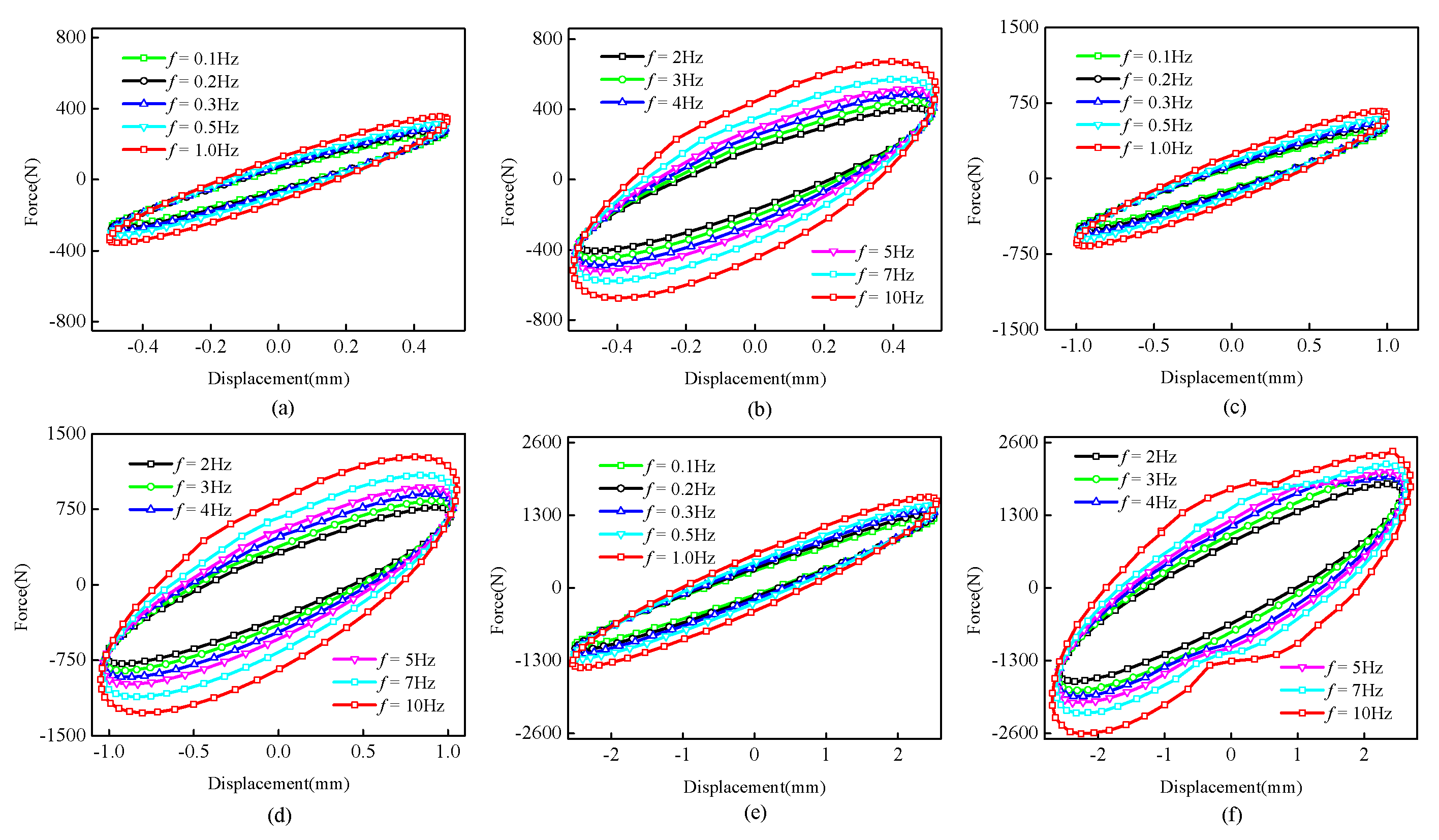

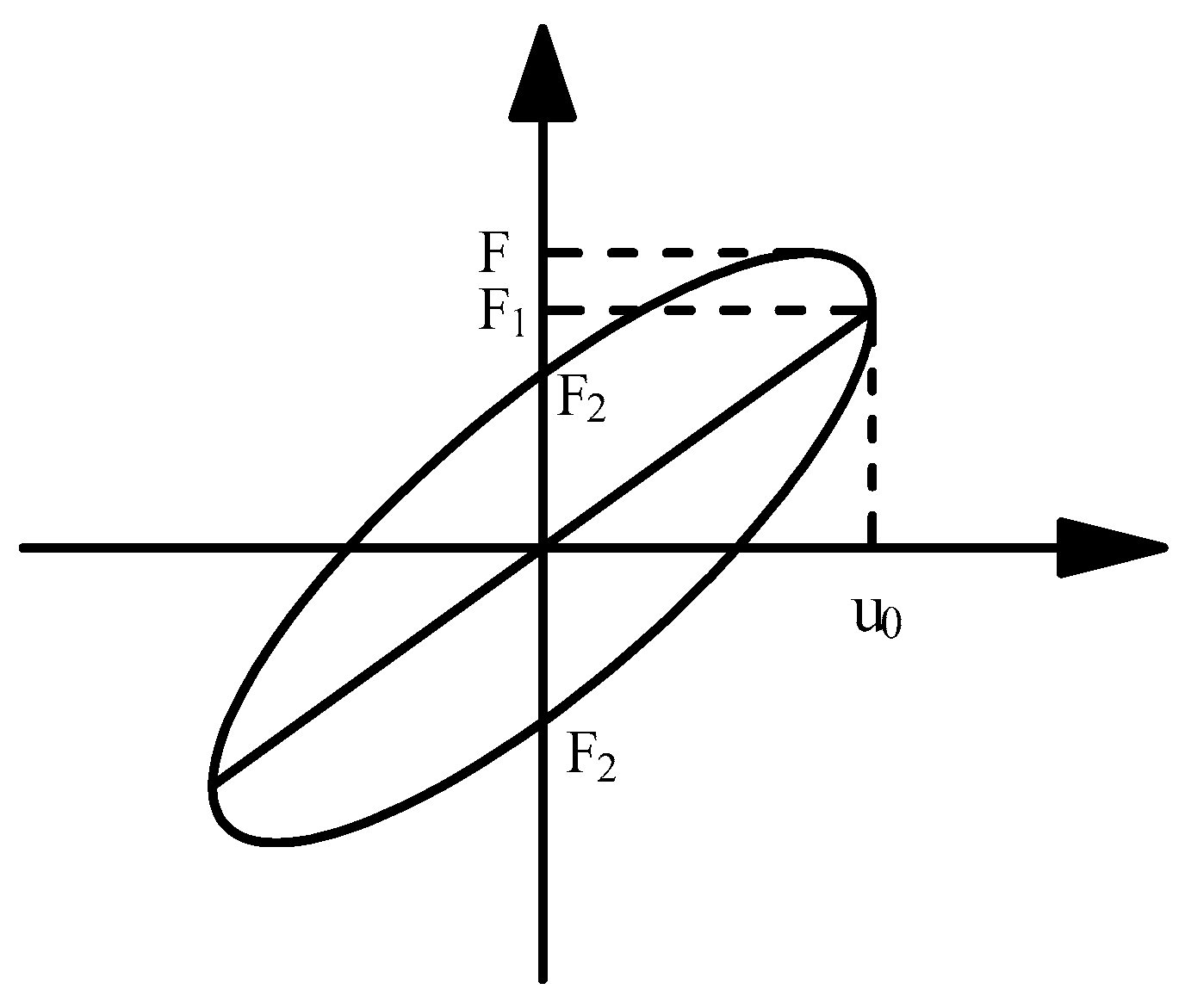
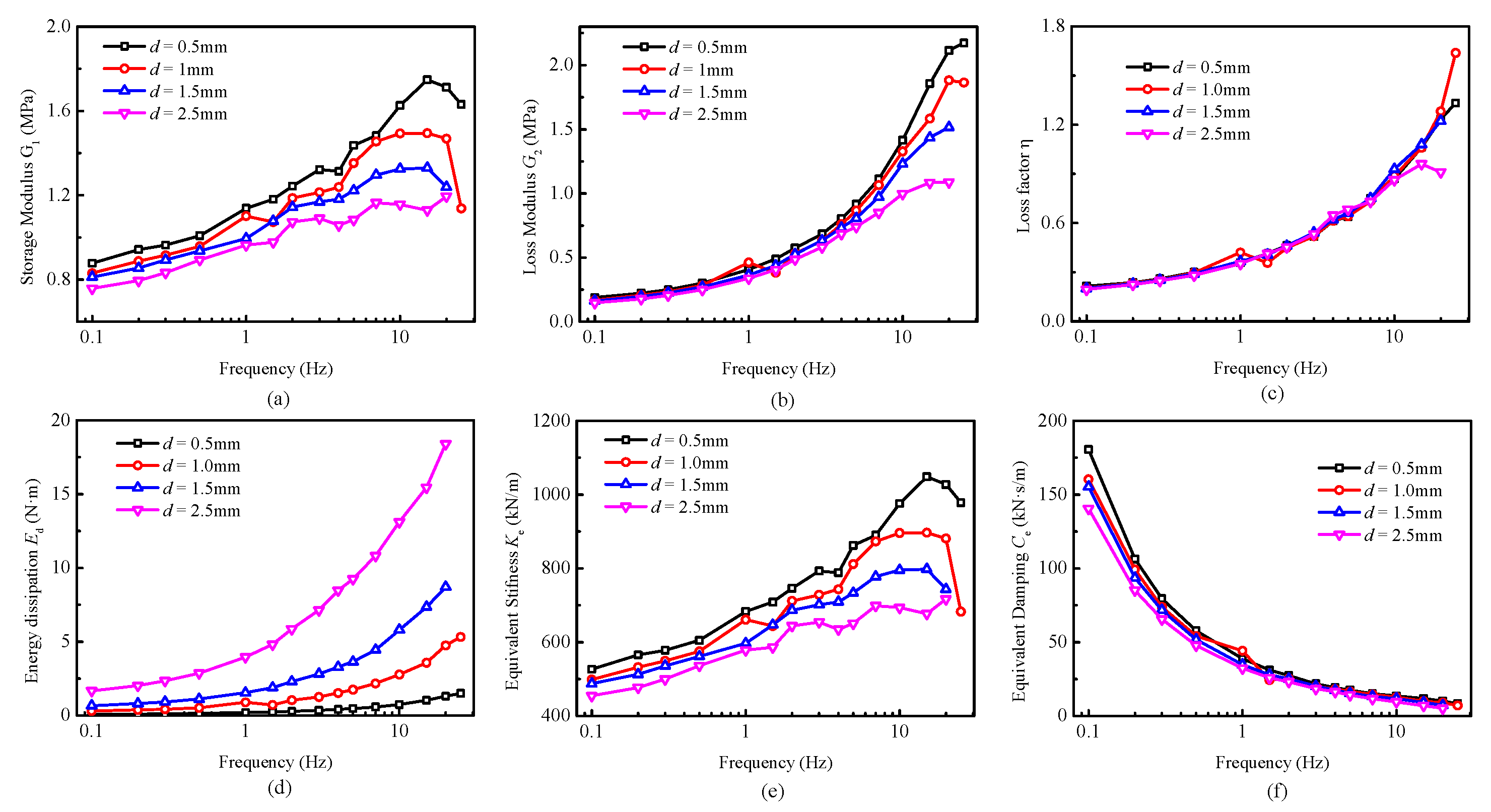
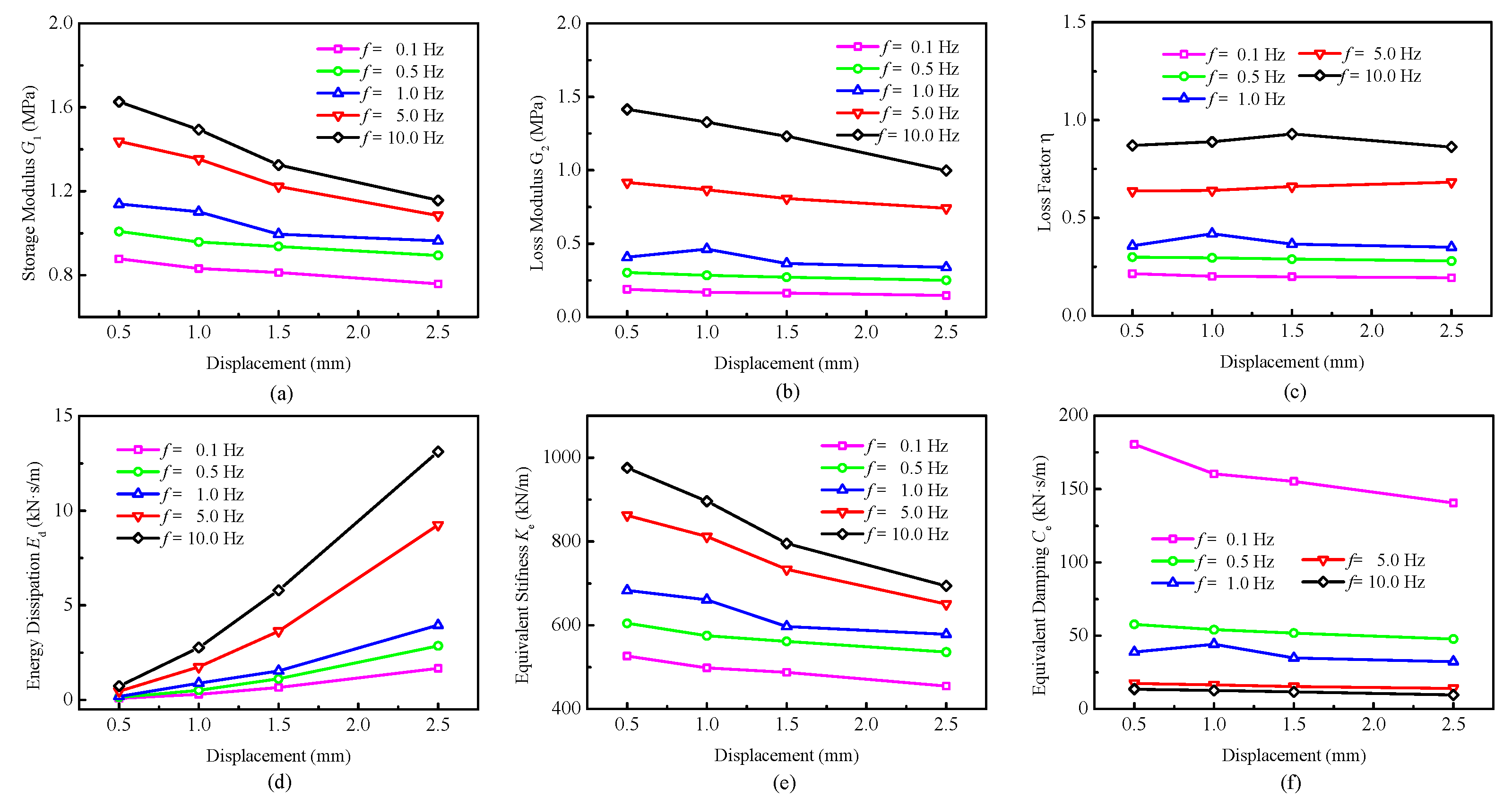

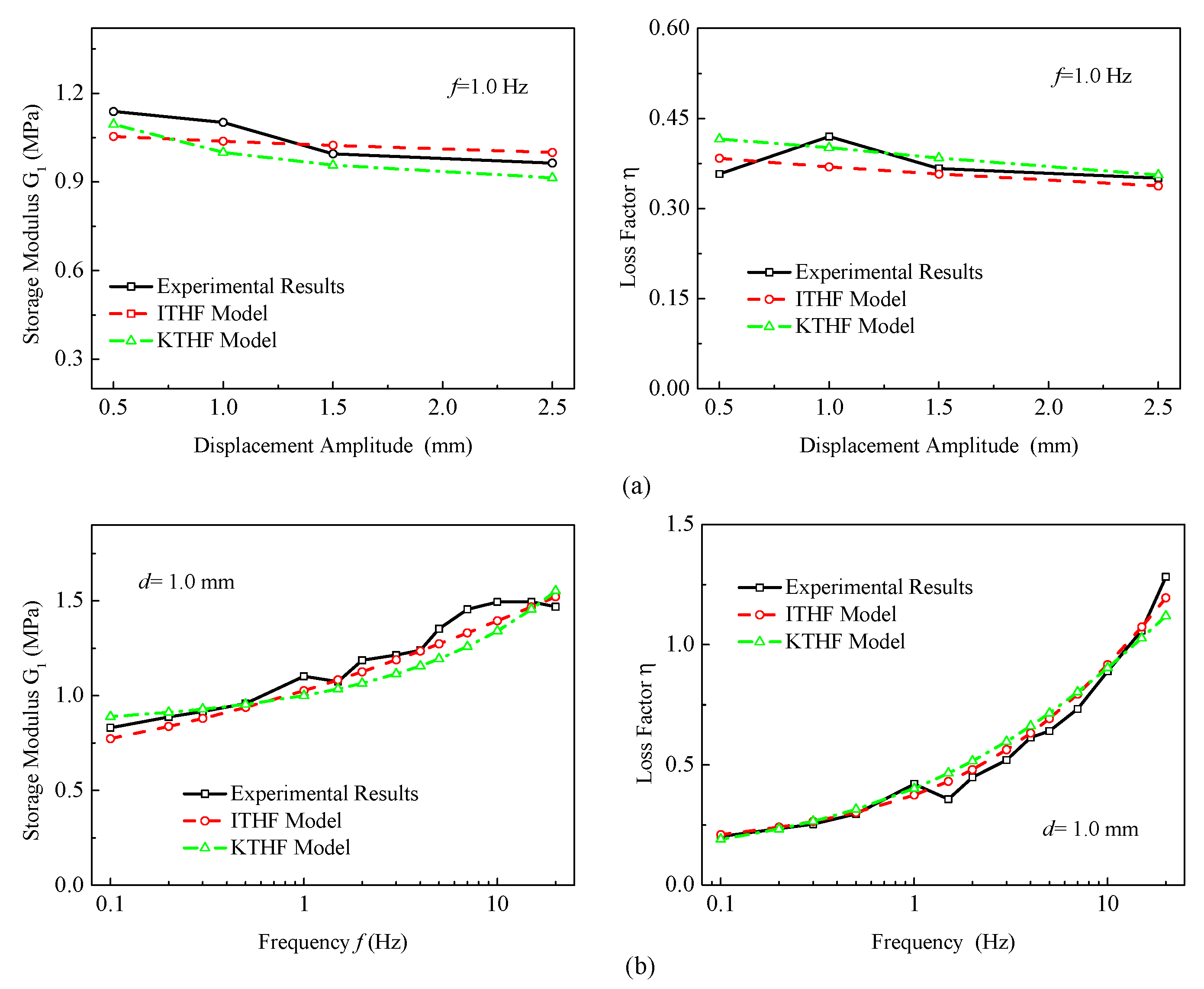
| Frequencies f (Hz) | Amplitudes d (mm) | Temperature T (°C) | Cycle Number |
|---|---|---|---|
| 0.1, 0.2, 0.3, 0.5, 1.0, 1.5, 2.0, 3.0, 4.0, 5.0, 7.0, 10.0, 15.0, 20.0, 25.0 | 0.5, 1.0, 1.5, 2.5 | 18 | 5 |
| Frequency f (Hz) | Displacement Amplitude d (mm) | Storage Modulus G1 (MPa) | Loss Modulus G2 (MPa) | Loss Factor η |
|---|---|---|---|---|
| 0.1 | 0.5 | 0.8774 | 0.1891 | 0.2155 |
| 1.0 | 0.8309 | 0.168 | 0.2022 | |
| 1.5 | 0.8123 | 0.1627 | 0.2002 | |
| 2.5 | 0.758 | 0.1472 | 0.1941 | |
| 0.5 | 0.5 | 1.0082 | 0.3025 | 0.3 |
| 1.0 | 0.9582 | 0.2836 | 0.296 | |
| 1.5 | 0.936 | 0.2711 | 0.2896 | |
| 2.5 | 0.8934 | 0.2501 | 0.28 | |
| 1.0 | 0.5 | 1.1385 | 0.4071 | 0.3576 |
| 1.0 | 1.1018 | 0.4627 | 0.42 | |
| 1.5 | 0.9952 | 0.3648 | 0.3666 | |
| 2.5 | 0.9638 | 0.3379 | 0.3506 | |
| 5.0 | 0.5 | 1.4372 | 0.9166 | 0.6378 |
| 1.0 | 1.3529 | 0.8668 | 0.6407 | |
| 1.5 | 1.2226 | 0.8076 | 0.6605 | |
| 2.5 | 1.0845 | 0.741 | 0.6833 | |
| 10.0 | 0.5 | 1.6264 | 1.4151 | 0.8701 |
| 1.0 | 1.4936 | 1.328 | 0.8891 | |
| 1.5 | 1.3255 | 1.2319 | 0.9294 | |
| 2.5 | 1.1564 | 0.9978 | 0.8628 | |
| 20.0 | 0.5 | 1.7128 | 2.1143 | 1.2344 |
| 1.0 | 1.4687 | 1.8828 | 1.2819 | |
| 1.5 | 1.2394 | 1.5164 | 1.2235 | |
| 2.5 | 1.1948 | 1.0873 | 0.91 |
| Frequency f (Hz) | Displacement Amplitude d (mm) | Energy Dissipation Ed (N·m) | Equivalent Stiffness Ke (KN/m) | Equivalent Damping Ce (KN·s/m) |
|---|---|---|---|---|
| 0.1 | 0.5 | 0.0859 | 526.4681 | 180.5752 |
| 1.0 | 0.3053 | 498.5189 | 160.4234 | |
| 1.5 | 0.664 | 487.4013 | 155.3158 | |
| 2.5 | 1.6705 | 454.776 | 140.5169 | |
| 0.5 | 0.5 | 0.1385 | 604.9157 | 57.7726 |
| 1.0 | 0.5195 | 574.9053 | 54.1656 | |
| 1.5 | 1.1186 | 561.5877 | 51.7731 | |
| 2.5 | 2.861 | 536.03 | 47.7705 | |
| 1.0 | 0.5 | 0.1906 | 683.0747 | 38.8732 |
| 1.0 | 0.8881 | 661.0809 | 44.1857 | |
| 1.5 | 1.5401 | 597.1266 | 34.8371 | |
| 2.5 | 3.9516 | 578.3022 | 32.2703 | |
| 5.0 | 0.5 | 0.4665 | 862.3496 | 17.5064 |
| 1.0 | 1.7457 | 811.7594 | 16.5545 | |
| 1.5 | 3.6414 | 733.5588 | 15.4236 | |
| 2.5 | 9.2452 | 650.7179 | 14.1523 | |
| 10.0 | 0.5 | 0.7364 | 975.8111 | 13.5127 |
| 1.0 | 2.7693 | 896.144 | 12.681 | |
| 1.5 | 5.7994 | 795.3137 | 11.7641 | |
| 2.5 | 13.1152 | 693.8486 | 9.5278 | |
| 20.0 | 0.5 | 1.3034 | 1027.6901 | 10.0951 |
| 1.0 | 4.7438 | 881.2364 | 8.9897 | |
| 1.5 | 8.7057 | 743.6433 | 7.2403 | |
| 2.5 | 18.4049 | 716.8831 | 5.1913 |
| Frequency f (Hz) | 0.1~0.5 | 0.5~1 | 1~5 | 5~10 | 10~20 |
|---|---|---|---|---|---|
| Storage modulus | +14.91% | +12.92% | +26.24% | +13.16% | +5.31% |
| Loss modulus | +59.97% | +34.58% | +125.15% | +54.39% | +49.41% |
| Loss factor | +39.21% | +19.2% | +78.36% | +36.42% | +41.87% |
| Energy dissipation | +61.23% | +37.62% | +144.75% | +57.86% | +77% |
| Equivalent stiffness | +14.9% | +12.92% | +26.25% | +13.16% | +5.32% |
| Equivalent damping | −68.01% | −32.71% | −54.97% | −22.81% | −25.29% |
| Displacement d (mm) | 0.5~1.0 | 1.0~1.5 | 1.5~2.5 |
|---|---|---|---|
| Storage modulus | −5.87% | −9.63% | −11.3% |
| Loss modulus | −5.43% | −6.83% | −8.25% |
| Loss factor η | +0.45% | +3.09% | +3.45% |
| Energy dissipation | +274.21% | +108.59% | +153.89% |
| Equivalent stiffness | −5.87% | −9.63% | −11.29% |
| Equivalent damping | −5.44% | −6.83% | −8.24% |
| Displacement Amplitude d (mm) | Characteristic Parameters | Experimental Results | Numerical Results | |||
|---|---|---|---|---|---|---|
| ITHF Model | Error | KTHF Model | Error | |||
| 0.5 | G1 (MPa) | 1.1385 | 1.0538 | 7.44% | 1.0953 | 3.94% |
| 0.3576 | 0.3836 | 7.23% | 0.4157 | 16.25% | ||
| 1 | G1 (MPa) | 1.1018 | 1.0379 | 5.8% | 1 | 3.64% |
| 0.42 | 0.3694 | 12.04% | 0.4015 | 4.41% | ||
| 1.5 | G1 (MPa) | 0.9952 | 1.0238 | 2.87% | 0.96 | 6.54% |
| 0.3666 | 0.3573 | 2.53% | 0.3841 | 4.78% | ||
| 2.5 | G1 (MPa) | 0.9638 | 1 | 3.76% | 0.91 | 8.59% |
| 0.3506 | 0.3377 | 3.68% | 0.3559 | 1.5% | ||
| Frequency f (Hz) | Characteristic Parameters | Experimental Results | Numerical Results | |||
|---|---|---|---|---|---|---|
| ITHF Model | Error | KTHF Model | Error | |||
| 0.1 | G1 (MPa) | 0.8309 | 0.7729 | 6.98% | 0.8895 | 15.08% |
| 0.2022 | 0.2093 | 3.51% | 0.1902 | 5.96% | ||
| 0.2 | G1 (MPa) | 0.8874 | 0.8376 | 5.62% | 0.9117 | 8.85% |
| 0.2342 | 0.2405 | 2.67% | 0.233 | 0.51% | ||
| 0.3 | G1 (MPa) | 0.9158 | 0.8798 | 3.93% | 0.9282 | 5.5% |
| 0.2533 | 0.2641 | 4.25% | 0.2651 | 4.65% | ||
| 0.5 | G1 (MPa) | 0.9582 | 0.938 | 2.11% | 0.9538 | 1.69% |
| 0.296 | 0.302 | 2.02% | 0.3146 | 6.28% | ||
| 1 | G1 (MPa) | 1.1018 | 1.0263 | 6.85% | 1 | 2.56% |
| 0.42 | 0.3741 | 10.93% | 0.4015 | 4.41% | ||
| 1.5 | G1 (MPa) | 1.0734 | 1.0831 | 0.9% | 1.0352 | 4.42% |
| 0.3565 | 0.4313 | 20.98% | 0.4647 | 30.35% | ||
| 2 | G1 (MPa) | 1.1868 | 1.1256 | 5.15% | 1.0648 | 5.4% |
| 0.4482 | 0.4803 | 7.15% | 0.5157 | 15.06% | ||
| 3 | G1 (MPa) | 1.2141 | 1.1887 | 2.09% | 1.1145 | 6.25% |
| 0.5197 | 0.5629 | 8.31% | 0.597 | 14.86% | ||
| 4 | G1 (MPa) | 1.2393 | 1.2356 | 0.3% | 1.1565 | 6.4% |
| 0.614 | 0.6322 | 2.97% | 0.6614 | 7.72% | ||
| 5 | G1 (MPa) | 1.3529 | 1.273 | 5.91% | 1.1935 | 6.24% |
| 0.6407 | 0.6925 | 8.08 | 0.7153 | 11.65% | ||
| 7 | G1 (MPa) | 1.4552 | 1.3311 | 8.53% | 1.2582 | 5.47% |
| 0.7325 | 0.7944 | 8.45% | 0.803 | 9.62% | ||
| 10 | G1 (MPa) | 1.4936 | 1.3945 | 6.64% | 1.3404 | 3.87% |
| 0.8891 | 0.9171 | 3.14% | 0.9038 | 1.66% | ||
| 15 | G1 (MPa) | 1.4949 | 1.4684 | 1.78% | 1.4547 | 0.93% |
| 1.0592 | 1.0739 | 1.38% | 1.0272 | 3.02% | ||
| 20 | G1 (MPa) | 1.4687 | 1.5217 | 3.61% | 1.5521 | 2% |
| 1.2819 | 1.1954 | 6.75% | 1.1194 | 12.67% | ||
Disclaimer/Publisher’s Note: The statements, opinions and data contained in all publications are solely those of the individual author(s) and contributor(s) and not of MDPI and/or the editor(s). MDPI and/or the editor(s) disclaim responsibility for any injury to people or property resulting from any ideas, methods, instructions or products referred to in the content. |
© 2023 by the authors. Licensee MDPI, Basel, Switzerland. This article is an open access article distributed under the terms and conditions of the Creative Commons Attribution (CC BY) license (https://creativecommons.org/licenses/by/4.0/).
Share and Cite
Xu, Y.; He, Q.; Guo, Y.-Q.; Huang, X.-H.; Dong, Y.-R.; Hu, Z.-W.; Kim, J. Experimental and Theoretical Investigation of Viscoelastic Damper by Applying Fractional Derivative Method and Internal Variable Theory. Buildings 2023, 13, 239. https://doi.org/10.3390/buildings13010239
Xu Y, He Q, Guo Y-Q, Huang X-H, Dong Y-R, Hu Z-W, Kim J. Experimental and Theoretical Investigation of Viscoelastic Damper by Applying Fractional Derivative Method and Internal Variable Theory. Buildings. 2023; 13(1):239. https://doi.org/10.3390/buildings13010239
Chicago/Turabian StyleXu, Yeshou, Qi He, Ying-Qing Guo, Xing-Huai Huang, Yao-Rong Dong, Zhong-Wei Hu, and Jinkoo Kim. 2023. "Experimental and Theoretical Investigation of Viscoelastic Damper by Applying Fractional Derivative Method and Internal Variable Theory" Buildings 13, no. 1: 239. https://doi.org/10.3390/buildings13010239
APA StyleXu, Y., He, Q., Guo, Y.-Q., Huang, X.-H., Dong, Y.-R., Hu, Z.-W., & Kim, J. (2023). Experimental and Theoretical Investigation of Viscoelastic Damper by Applying Fractional Derivative Method and Internal Variable Theory. Buildings, 13(1), 239. https://doi.org/10.3390/buildings13010239











